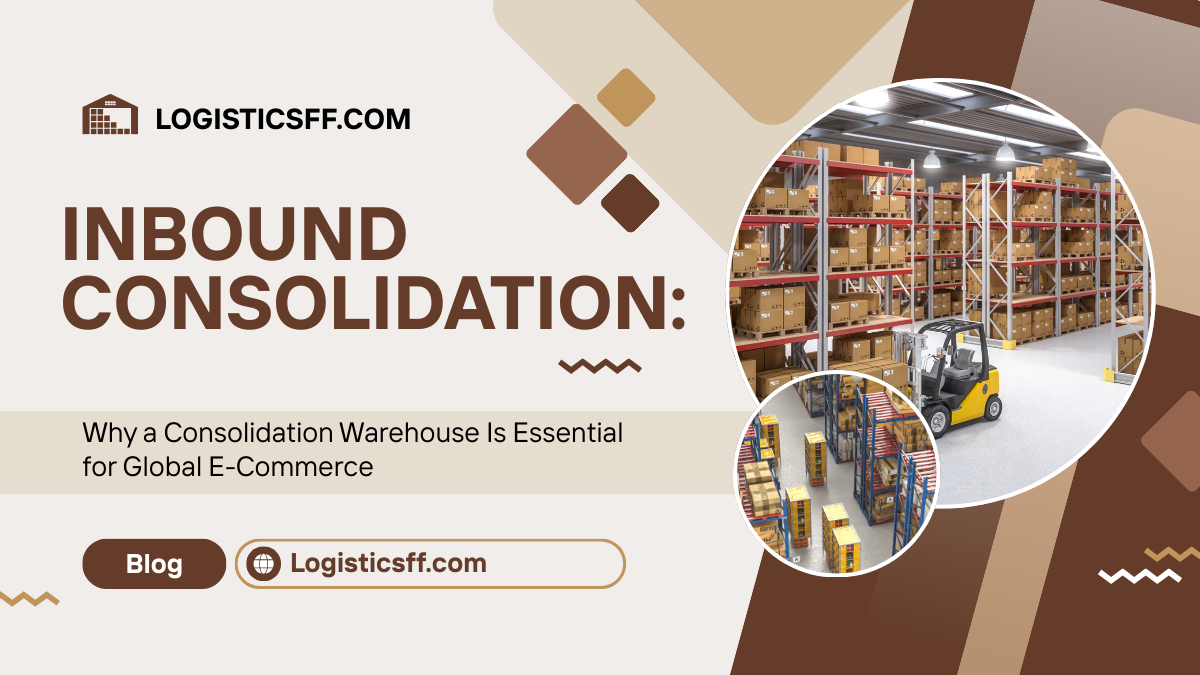1. Introduction: The Rise of Inbound Consolidation in E-Commerce
2. What Is Inbound Consolidation?
3. Why Inbound Consolidation Matters for DTC and Dropshipping Brands
4. How a Consolidation Warehouse Works
5. Special Case: Consolidation for Beauty Products
6. The Role of 3PL in Inbound Consolidation
7. How FF Logistics Handles Consolidation Warehousing
8. Conclusion: Turning Supplier Complexity into Growth
Introduction
In today’s global e-commerce landscape, sourcing from multiple suppliers has become the norm—especially for DTC brands and dropshipping sellers working with Chinese manufacturers. While this offers flexibility in product variety and cost, it also introduces complexity: fragmented shipments, higher logistics costs, inconsistent timelines, and customs headaches.
This is where inbound consolidation and consolidation warehouses come into play. By centralizing inventory from multiple suppliers into one warehouse before fulfillment, brands gain efficiency, cost savings, and better control over their supply chain.
Inbound consolidation has become particularly relevant as global e-commerce supply chains grow more fragmented. Many brands source components from specialized factories—one may produce glass containers, another manufactures printed packaging, and another supplies the actual product. Without consolidation, each of these shipments would require separate customs entries and independent last-mile arrangements, creating unnecessary overhead. Furthermore, buyers often underestimate how much disjointed deliveries impact customer experience: receiving multiple boxes at different times increases returns, customer service inquiries, and even negative reviews. By integrating consolidation early, businesses not only reduce cost but also set a foundation for scalability—allowing them to introduce new SKUs or seasonal product lines without multiplying logistics complexity.

What Is Inbound Consolidation?
Beyond simply merging shipments, inbound consolidation involves building visibility across the entire upstream supply chain. A well-managed consolidation warehouse doesn’t just accept goods; it also ensures inventory is barcoded, digitally tracked, and reconciled against purchase orders. This provides sellers with immediate insight into what stock has arrived, which SKUs are ready for fulfillment, and what remains pending from suppliers. For cross-border e-commerce, this step is critical because delays or shortages are identified before orders go live. In addition, consolidation enables cost-optimization strategies such as cartonization (right-sizing boxes across suppliers), palletization for air or sea freight, and reducing dimensional weight (DIM). Together, these techniques ensure that inbound logistics are not only cheaper but also more predictable—something that is especially valuable in volatile peak seasons like Q4 or Singles’ Day.
Inbound consolidation is the process of gathering goods from different suppliers or factories into one central warehouse before orders are processed, packed, and shipped to customers. Instead of paying for multiple small shipments, sellers combine inventory into larger, more cost-effective shipments.
• Example scenario (generic): A brand sources skincare from Supplier A, makeup brushes from Supplier B, and packaging materials from Supplier C. Without consolidation, each order would travel separately—adding cost and delay. With inbound consolidation, all items are delivered to a single warehouse in Shenzhen, inspected, combined, and shipped together.
Why Inbound Consolidation Matters for DTC and Dropshipping Brands
1. Cost Efficiency
• Multiple small parcels → higher freight cost per unit.
• Consolidation reduces shipping fees by using larger, more economical shipments.
• Saves on import duties/taxes by filing under one entry.
2. Faster Fulfillment
• Orders are ready to ship once consolidated.
• Streamlined customs clearance with fewer documents.
• Faster processing → improved delivery times.
3. Quality Control and Accuracy
• Central warehouse can check all incoming goods.
• Identify supplier errors before products reach customers.
• Consolidation ensures consistent packaging and branding.
4. Customer Experience
• Customers receive one parcel instead of multiple split shipments.
• Reduced risk of damaged or missing items.
• Enhances brand professionalism.
For DTC and dropshipping sellers, the benefits compound over time. A fragmented supply chain often leads to hidden costs, such as customer support teams handling multiple “Where is my package?” queries, or higher chargebacks when customers receive incomplete orders. Consolidation warehouses eliminate these inefficiencies by synchronizing all inventory into a single outbound flow. From a financial standpoint, reducing customs entries from five invoices to one could save thousands of dollars annually in handling and duty fees. From an operational standpoint, it allows sellers to leverage data analytics—tracking inventory turnover rates, monitoring supplier reliability, and forecasting demand more accurately. For beauty brands especially, where presentation and consistency are non-negotiable, inbound consolidation provides the backbone for scaling without sacrificing customer satisfaction.
How a Consolidation Warehouse Works
1. Receiving Goods
• The warehouse accepts goods from multiple suppliers.
• Items are checked for quantity and condition.
2. Inspection and Quality Control
• Verify compliance with international shipping standards.
• Especially important for beauty products (liquids, creams, fragile packaging).
3. Storage and Organization
• SKUs are labeled, barcoded, and stored by category.
• Inventory management system provides real-time tracking.
4. Pick, Pack, and Ship
• Orders are combined from consolidated stock.
• Branded or eco-friendly packaging added.
• Shipped via express, postal, or dedicated lines.
Modern consolidation warehouses also integrate advanced warehouse management systems (WMS) to ensure efficiency. These systems support real-time inventory dashboards, SKU-level traceability, and automated alerts when discrepancies occur. For example, if a supplier sends defective or short-shipped products, the warehouse can flag the issue instantly, preventing downstream customer disappointment. Many warehouses also provide value-added services like kitting, relabeling, or secondary packaging, which streamline compliance with different regional requirements. For e-commerce brands, the warehouse essentially acts as a control tower, turning scattered supplier deliveries into a streamlined outbound process. This ensures that by the time products leave the facility, they are not only combined but also standardized—ready to meet the expectations of global consumers.
Special Case: Consolidation for Beauty Products
Beauty and cosmetics brands face unique sourcing and logistics challenges:
• Fragile glass containers require stronger protective materials.
• Compliance needs such as MSDS documents, FDA/EU labeling, batch numbers.
• Multiple suppliers (serums, mascaras, brushes, packaging) need to be combined.
• Seasonal launches like gift sets or limited collections benefit greatly from consolidation warehouses.
Without consolidation, beauty brands risk fragmented customer experience—receiving skincare in one parcel and brushes in another. With inbound consolidation, the entire brand experience is unified.
Another important aspect is managing shelf life and batch codes. Cosmetics and skincare often carry expiry dates and batch tracking requirements, especially for compliance in the EU and U.S. A consolidation warehouse can track these details and ensure older stock is prioritized for dispatch (FIFO or FEFO models). This reduces the risk of expired goods reaching customers and safeguards brand reputation. Additionally, beauty products face stricter labeling rules—ingredients, allergens, and warnings must be visible in the local language. By consolidating inventory in a central facility, brands can handle relabeling or add region-specific inserts before shipping. This kind of flexibility would be nearly impossible if products were dispatched separately from multiple suppliers. In effect, consolidation not only protects margins but also preserves compliance and brand image.
The Role of 3PL in Inbound Consolidation
A reliable 3PL (third-party logistics) provider makes consolidation seamless by offering:
• Centralized China warehouse close to suppliers.
• Inbound receiving and free storage (up to 90 days).
• Quality control before shipping.
• Integration with Shopify, WooCommerce, Amazon, TikTok Shop.
• Multiple shipping options: express, postal, dedicated lines (DDP available).
Third-party logistics providers (3PLs) are uniquely positioned to manage inbound consolidation because they already operate at the intersection of warehousing, compliance, and shipping. Unlike a single supplier warehouse, a 3PL acts as a neutral partner capable of handling goods from multiple sources, ensuring fair and consistent treatment of all SKUs. For fast-scaling e-commerce brands, working with a 3PL also opens the door to advanced logistics services like duty-paid shipping (DDP), multi-channel integration, and regional fulfillment hubs. Importantly, 3PLs bring economies of scale—because they serve many clients simultaneously, they can negotiate better shipping rates and offer flexible storage policies such as free or discounted periods. For brands still in the growth stage, leveraging these capabilities can mean the difference between struggling with fragmented suppliers and enjoying a smooth, scalable supply chain.
How FF Logistics Handles Consolidation Warehousing
At FF Logistics, inbound consolidation is one of our specialties—particularly for beauty and lifestyle brands sourcing from multiple factories.
• Supplier Coordination: We receive goods from all your suppliers in China, store them in one Shenzhen warehouse, and prepare them for global shipping.
• Free Storage & No MOQ: Enjoy up to 90 days free storage and no minimum order requirements, ideal for startups testing new SKUs.
• Custom Packaging: Add branded boxes, thank-you cards, or eco-friendly materials to reinforce your identity.
• Quality Control: Our team checks items before outbound shipping to prevent errors or damages.
• Flexible Shipping: Choose from express (DHL, FedEx, UPS), postal, or dedicated line shipping to the U.S. and Europe—delivering in as little as 2–4 days.
• Discreet Shipping: We can remove “Shipped from China” labels for a seamless customer experience.
Many brands leveraging FF Logistics’ consolidation service have reported significant reductions in logistics costs, faster delivery times, and a more unified customer experience compared to managing multiple suppliers separately.
At FF Logistics, consolidation is not treated as an add-on service but as a foundation for global fulfillment. Our Shenzhen-based consolidation hub is strategically located near China’s key manufacturing clusters, reducing inland freight costs and lead times. For beauty and lifestyle brands, this location is especially valuable, as many cosmetic packaging and product suppliers are concentrated in the Pearl River Delta. By centralizing here, brands minimize supplier coordination headaches and gain a single point of control. Beyond storage and fulfillment, we also provide detailed reporting—stock status, supplier performance, and cost breakdowns—helping brands make informed decisions. This transparency, coupled with our fast fulfillment (1 day processing, 2–4 day delivery) and customer-centric policies (free 90-day storage, compensation guarantee), positions FF Logistics as more than just a warehouse—it’s a long-term growth partner for DTC sellers.

Conclusion
Inbound consolidation is no longer optional—it’s essential for modern DTC and dropshipping brands sourcing from China. A consolidation warehouse saves costs, improves speed, enhances compliance, and delivers a better customer experience.
For beauty brands especially, consolidation ensures fragile products arrive safely and customers receive a consistent unboxing experience.
Inbound consolidation should be viewed not only as a logistics tactic but also as a strategic growth enabler. Brands that adopt consolidation early tend to scale faster, because their operations are less dependent on the limitations of individual suppliers. Instead of firefighting daily issues like split shipments, missing items, or customs delays, these brands can focus resources on marketing, customer engagement, and product innovation. In a highly competitive e-commerce landscape, this shift of focus is critical: operational efficiency directly translates into brand reputation and profitability. For beauty brands competing against giants, a seamless and professional fulfillment process can be the differentiator that builds long-term loyalty.
With FF Logistics, you gain a partner who understands not just logistics, but the unique needs of DTC and beauty fulfillment. From inbound consolidation to last-mile delivery, we help you turn supply chain complexity into a growth advantage.
Ready to optimize your supply chain with inbound consolidation? Contact FF Logistics today for a tailored solution.
Copyright © 2025 FF Logistics Ltd. All rights reserved.






